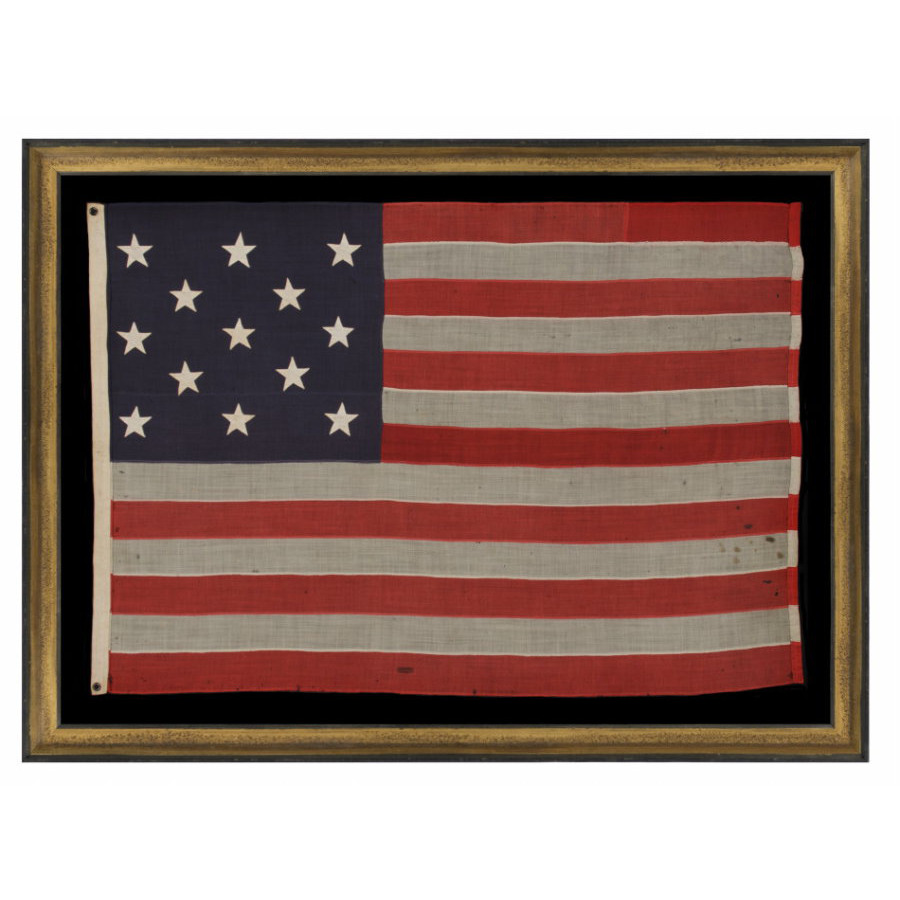
| |
13 STARS IN A 3-2-3-2-3 CONFIGURATION, AN ATTRACTIVE FLAG IN A SMALL SCALE WITH PLEASING PROPORTIONS, MADE BETWEEN 1876 AND THE 1890's |
|
| Available: |
Sold |
| Frame Size (H x L): |
Approx. 58.5" x 80" |
| Flag Size (H x L): |
47.5" x 69" |
|
| Description....: |
|
13 STARS IN A 3-2-3-2-3 CONFIGURATION, AN ATTRACTIVE FLAG IN A SMALL SCALE WITH PLEASING PROPORTIONS, MADE BETWEEN 1876 AND THE 1890's:
13 star American national flag, probably dating to the last decade of the 19th century, though perhaps slightly earlier. The stars are arranged are arranged in staggered lineal rows in counts of 3-2-3-2-3, which is the most common configuration found in 19th century flags with 13 stars. In most cases the 3-2-3-2-3 design can also be viewed as a diamond of stars, with a star in each corner and a star in the very center. It can also be interpreted as a combination of the crosses of St. Andrew and St. George, which some experts feel could have been the design of the very first American flag, serving as a link between this star pattern and the British Union Jack. The pattern is often attributed--erroneously in my opinion--to New Jersey Senator Francis Hopkinson, a member of the Second Continental Congress and signer of the Declaration of Independence, who is credited with having played the most significant role in the original design of the American national flag. Hopkinson's original drawings for the design of the flag have not survived and his other depictions of 13 star arrangements for other devices are not consistent.
Why 13 Stars?
The U.S. Navy used 13 stars on ensigns made for small boats, because they wished the stars to be easily discerned at a distance. This was the original number of stars on the American flag, representing the number of original colonies. As the number of stars grew with the addition of new states, two circumstances occurred. One, it became more and more difficult to fit stars on a small flag and two, it became more difficult to view them from afar as individual objects.
When small flags were produced, commercial makers often applied the same logic as the Navy, selecting the 13 star count, rather than the full complement of stars, for the sake of ease and visibility. Any American national flag that has previously been official, remains so today according to the flag acts, so 13 star flags were, and still are, official flags of the United States.
13 star flags have been used throughout our nation's history for a variety of purposes. In addition to their use by the Navy and commercial makers on small scale flags, they were produced for patriotic events, such as the annual observance of Independence Day, flown by politicians when campaigning for office, and hoisted on private ships. The Navy's use of the 13 star count on small boats officially ended in 1916 following an executive order of President Woodrow Wilson.
This particular flag is larger than most 13 star examples of the 1890's. At approximately 6 feet in length, this was a transitional size, where either 13 stars or the full compliment could be seen on a commercially made flag.
Construction: The flag is entirely treadle sewn with a wool canton and stripes. The canton was pieced using two lengths of wool bunting. The looms commonly used at the time for wool bunting produced fabric that was 18 inches wide so any canton larger than that on the hoist or fly measurement was necessarily made of more than one length of cloth. The stars are made of cotton, double-appliqued, and sewn with a lineal stitch. This stitch is most commonly seen on the stars of flags that date to the brief period between 1890 and 1895. There is a canvas sailcloth binding along the hoist, with 2 brass grommets. "6 ft" was penciled near the top to indicate size.
Mounting: The flag has been hand-stitched to 100% silk organza on every seam and throughout the star field. The flag was then hand-stitched to a background of 100% cotton, black in color, which was washed to remove excess dye. An acid-free agent was added to the wash to further set the dye, and the fabric was heat-treated for the same purpose. The mount was then placed in a black-painted, hand-gilded and distressed Italian molding. The glazing is U.V. protective plexiglass.
Condition: Approximately two fifths of the top red stripe was carefully replaced at the fly end with period wool bunting. This repair was probably made during the period of the flag's use. There is very minor mothing in a couple of areas and two minor tears in the bottom red stripe with associated breakdown. There are minor stains at the extreme fly end of the 9th and 10th stripes. many of my clients prefer early flags to show their age and history of use. |
|
|
|
| Collector Level: |
Intermediate-Level Collectors and Special Gifts |
|
| Flag Type: |
Sewn flag |
|
| Star Count: |
13 |
|
| Earliest Date of Origin: |
1880 |
|
| Latest Date of Origin: |
1900 |
|
| State/Affiliation: |
13 Original Colonies |
|
| War Association: |
|
|
| Price: |
SOLD |
|
| |
Views: 2425 |
|
|
|

